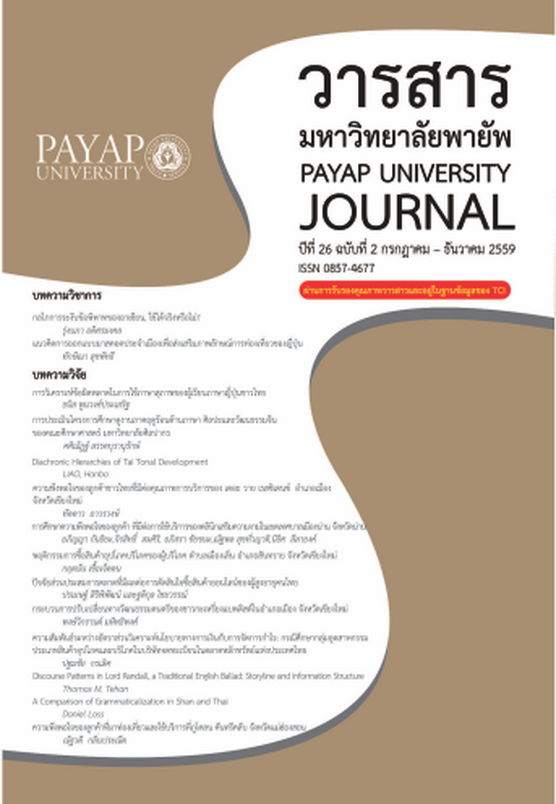การวิเคราะห์ข้อผิดพลาดในการใช้ภาษาสุภาพของผู้เรียนภาษาญี่ปุ่นชาวไทย
Main Article Content
Abstract
This research aimed to investigate errors and misunderstanding about using honorific expression among Japanese Language Thai learners. Eighty five 3 rd and 4 th year Japanese major students were the samples for this research. Filling verb in the blank according to situation 10 items were used to collect data. After that, follow up interview was conducted to complete the research.The study found that frequency and error pattern varied depending on types of Honorific expression. (1) Sonkeigo: most frequently appeared error was verb conjugation pattern (O+Verb) (2) Sonkeigo (irregular verb“Do”) and Teichougo(irregular verb “Have”): most frequently appeared error was inappropriation of using honorific expression. (3) Kenjougo (irregular verb “Go”): most frequently appeared error was switching type of honorific expression.Learners tend to use verb “Mairimasu” and “Ukagaimasu”alternately. (4)Teichougo(irregular verb “Go”): most frequently appeared error was using “Orimasu” instead of “Mairimasu”. (5) Teineigo: most frequently appeared error was switching type of honorific expression. Learners’ misunderstanding were (1) Using Sonkeigo toward speaker and in-group’s action (2) Not using Teichougo toward abstract noun being subject of sentence (3) Not using Sonkeigo and Kenjogo when speaking with out-group (4) Not using Sonkeigo toward superior when speaking with in-group.
Article Details
References
บุษบา บรรจงมณี, วันชัย สีลพันธ์กุล และ ทัศนีย์ เมธาพิสิฐ. (2552). ภาษาญี่ปุ่น อะกิโกะโตะโทะโมะดะจิ 6. กรุงเทพมหานคร: คิโนะคูนิยะ บุ๊คสโตร์.
ยูตากะ คูซานางิ. (2552). ภาษาสุภาพเพื่อเข้าสังคมญี่ปุ่น. แปลโดยเสาวรีย์ นากางาว่า. กรุงเทพมหานคร: ภาษาและวัฒนธรรม.
庵功雄[Iori]. (2012).『新しい日本語学入門』第2版. スリーエーネットワーク.
岡野喜美子[Okano]. (2000). 「留学生の待遇表現使用 : 発話調査の結果から」『早稲田大学日本語研究教育センター紀要』13, 1-13.
魏春娥[Gi]. (2014). 「日本人と外国人日本語学習者の敬語使用に関する考察―敬語表現調査の結果の分析を中心に」『山口大学文学会誌』37, 52-64.
スリーエーネットワーク[3A Corporation]. (1998).『みんなの日本語初級II』スリーエーネットワーク.
戸田和子・小柳津智子[Toda & Oyaizu]. (2013).「外国語として日本語の敬意表現学習における問題点-大学留学生別科日本語教育課程の事例から-」『湘南工科大学紀要』47 (1), 85-90.
文化庁[Agency for Cultural Affairs]. (2007).『敬語の指針』(http://www.bunka.go.jp/bunkashingikai/soukai/pdf/keigo_tousin.pdf) (2015年1月13日参照)
文化庁[Agency for Cultural Affairs]. (2013).『平成24年度「国語に関する世論調査」の結果の概要』国立印刷局.
宮田剛章[Miyata]. (2005). 「中国人・韓国人学習者と日本語母語話者に見られる敬語動詞の誤用訂正能力」『ジャーナルCAJLE』 7, 59-74.

